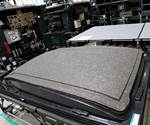Recycled carbon fiber update: The supply side
Commercial recyclers aren’t alone in their pursuit of fiber reclamation. Textile converters have joined the effort.
Commercial recyclers aren’t alone in their pursuit of fiber reclamation. Textile converters have joined the effort, enjoying a plentiful and secure supply of internally generated raw material.
FORMAX (Narborough, Leicestershire, U.K.), for example, is converting virgin fiber waste from its manufacture of noncrimp fabrics (NCF) into nonwoven mats that can be used in composite parts. According to Managing Director Oliver Wessely, waste such as edge trim is cut off, sucked into a vacuum and converted into a discontinuous fiber sheet, which “can then be used as a print-stop barrier or bulking layer in infused marine or architectural parts, for example.” FORMAX is also developing materials for use in Class A surface automotive parts. “The discontinuous fibers produce absolutely no print-through,” claims Wessely, “and also enable good formability for parts with complex geometry.” He asserts the material processes well in press molding and would be ideal for fabricators who currently use sheet molding compound (SMC). “It can produce very good properties depending upon the resin and process used,” he claims, ”and is being trialed now at a number of our automotive customers who are expressing great interest.”
With current production at 700 metric tonnes of carbon fabric annually (over 1.5 million lb/yr), and 7 percent waste, Wessely says FORMAX already has a good supply, “but as we grow this will only increase. Also, our customers are typically generating 25 percent waste from nesting as they cut out plies prior to preforming and/or laying and we also run this through our process.” He says the company is now transitioning from lab scale to commercialization. Fiber lengths range between 50 and 75 mm (2 and 3 inches), with the original applied sizing intact, and the resulting textile reportedly drapes and handles like a heavy veil.
Likewise, Sigmatex (Norton, Cheshire, U.K.) is also collecting dry carbon fiber production scrap — discontinuous virgin fibers mainly between 45 and 60 mm (1.8 to 2.4 inches) long — which it then combines with thermoplastic and weaves into tapes or noncrimp fabric (NCF) with more than 60 percent tensile strength and 90 percent modulus vs. VCF fabric at a lower price. “We worked with the U.K. government-funded FiberCycle program, where the aim was to develop this for large-scale composite applications,” says commercial manager Mike Hitchen. He notes that these RCF products are marginally cheaper than NCF using the most cost-effective virgin fibers, but that real cost reduction is achieved through reduced part cycle time through heated press stamping and the removal of resin from the manufacturing process. The first commercial SigmaRF product is a ±45 biaxial 220 g/m2 (6.5 oz/yd2) NCF. It contains 3 percent PET stitching thread and is 48 percent CF by weight. Sigmatex has sold the fabric into press-molded parts for an automotive component and also developed options using polyamide (PA), polyethersulfone (PES) and polyetherimide (PEI).
Editor's note: This short article is a sidebar to a feature article titled "Recycled Carbon fiber update: Closing the CFRP Lifecycle Loop." To read the main article, click on its title under "Editor's Picks," at top right.
Related Content
ASCEND program update: Designing next-gen, high-rate auto and aerospace composites
GKN Aerospace, McLaren Automotive and U.K.-based partners share goals and progress aiming at high-rate, Industry 4.0-enabled, sustainable materials and processes.
Read MoreBio-based acrylonitrile for carbon fiber manufacture
The quest for a sustainable source of acrylonitrile for carbon fiber manufacture has made the leap from the lab to the market.
Read MoreMaterials & Processes: Resin matrices for composites
The matrix binds the fiber reinforcement, gives the composite component its shape and determines its surface quality. A composite matrix may be a polymer, ceramic, metal or carbon. Here’s a guide to selection.
Read MoreRecycling end-of-life composite parts: New methods, markets
From infrastructure solutions to consumer products, Polish recycler Anmet and Netherlands-based researchers are developing new methods for repurposing wind turbine blades and other composite parts.
Read MoreRead Next
Recycled carbon fiber update: Closing the CFRP lifecycle loop
Commercial production of recycled carbon fiber currently outpaces applications for it, but materials characterization and new technology demonstrations promise to close the gap.
Read MoreRecycled carbon fiber update: Closing the CFRP lifecycle loop
Commercial production of recycled carbon fiber currently outpaces applications for it, but materials characterization and new technology demonstrations promise to close the gap.
Read MoreComposites end markets: Energy (2024)
Composites are used widely in oil/gas, wind and other renewable energy applications. Despite market challenges, growth potential and innovation for composites continue.
Read More














.jpg;maxWidth=300;quality=90)









